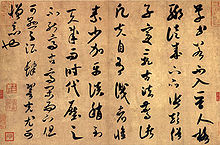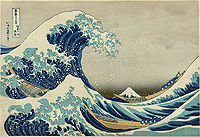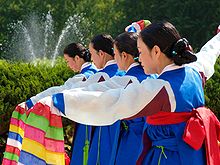 Culture of China
Culture of China
 Confucianism was the official philosophy throughout most of Imperial China’s history, and mastery of Confucian texts was the primary criterion for entry into the imperial bureaucracy. China’s traditional values were derived from various versions of Confucianism. A number of more authoritarian strains of thought have also been influential, such as Legalism.
Confucianism was the official philosophy throughout most of Imperial China’s history, and mastery of Confucian texts was the primary criterion for entry into the imperial bureaucracy. China’s traditional values were derived from various versions of Confucianism. A number of more authoritarian strains of thought have also been influential, such as Legalism.
There was often conflict between the philosophies, e.g. the Song Dynasty Neo-Confucians believed Legalism departed from the original spirit of Confucianism. Examinations and a culture of merit remain greatly valued in China today. In recent years, a number of New Confucians (not to be confused with Neo-Confucianism) have advocated that democratic ideals and human rights are quite compatible with traditional Confucian “Asian values”.
With the rise of European economic and military power beginning in the mid-19th century, non-Chinese systems of social and political organization gained adherents in China. Some of these would-be reformers totally rejected China’s cultural legacy, while others sought to combine the strengths of Chinese and European cultures. In essence, the history of 20th-century China is one of experimentation with new systems of social, political, and economic organization that would allow for the reintegration of the nation in the wake of dynastic collapse.
Arts, scholarship, and literature
Calligraphy later became commercialized, and works by famous artists became prized possessions. Chinese literature has a long past; the earliest classic work in Chinese, the I Ching or “Book of Changes” dates to around 1000 BC. A flourishing of philosophy during the Warring States Period produced such noteworthy works as Confucius’s Analects and Laozi’s Tao Te Ching. (See also: the Chinese classics.) Dynastic histories were often written, beginning with Sima Qian’s seminal Records of the Grand Historian, which was written from 109 BC to 91 BC.
The Tang Dynasty witnessed a poetic flowering, while the Four Great Classical Novels of Chinese literature were written during the Ming and Qing Dynasties. Printmaking in the form of movable type was developed during the Song Dynasty. Academies of scholars sponsored by the empire were formed to comment on the classics in both printed and handwritten form. Royalty frequently participated in these discussions as well.
The Song Dynasty was also a period of great scientific literature, and saw the creation of works such as Su Song’s Xin Yixiang Fayao and Shen Kuo’s Dream Pool Essays. There were also enormous works of historiography and large encyclopedias, such as Sima Guang’s Zizhi Tongjian of 1084 AD or the Four Great Books of Song fully compiled and edited by the 11th century.
For centuries, religious and social advancement in China could be achieved through high performance on the imperial examinations. This led to the creation of a meritocracy, although success was available only to males who could afford test preparation. Imperial examinations required applicants to write essays and demonstrate mastery of the Confucian classics. Those who passed the highest level of the exam became elite scholar-officials known as jinshi, a highly esteemed socio-economic position.
Chinese philosophers, writers and poets were highly respected and played key roles in preserving and promoting the culture of the empire. Some classical scholars, however, were noted for their daring depictions of the lives of the common people, often to the displeasure of authorities. The Chinese invented numerous musical instruments, such as the zheng (zither with movable bridges), qin (bridgeless zither), sheng (free reed mouth organ), and xiao (vertical flute) and adopted and developed others such the erhu (alto fiddle or bowed lute) and pipa (pear-shaped plucked lute), many of which later spread throughout East Asia and Southeast Asia, particularly to Japan, Korea, and Vietnam.
![]() Culture of Japan
Culture of Japan
 Japanese culture has evolved greatly from its origins. Contemporary culture combines influences from Asia, Europe and North America. Traditional Japanese arts include crafts such as ceramics, textiles, lacquerware, swords and dolls; performances of bunraku, kabuki, noh, dance, and rakugo; and other practices, the tea ceremony, ikebana, martial arts, calligraphy, origami, onsen, Geisha and games. Japan has a developed system for the protection and promotion of both tangible and intangible Cultural Properties and National Treasures. Sixteen sites have been inscribed on the UNESCO World Heritage List.
Japanese culture has evolved greatly from its origins. Contemporary culture combines influences from Asia, Europe and North America. Traditional Japanese arts include crafts such as ceramics, textiles, lacquerware, swords and dolls; performances of bunraku, kabuki, noh, dance, and rakugo; and other practices, the tea ceremony, ikebana, martial arts, calligraphy, origami, onsen, Geisha and games. Japan has a developed system for the protection and promotion of both tangible and intangible Cultural Properties and National Treasures. Sixteen sites have been inscribed on the UNESCO World Heritage List.
Art
The Shrines of Ise have been celebrated as the prototype of Japanese architecture. Largely of wood, traditional housing and many temple buildings see the use of tatami mats and sliding doors that break down the distinction between rooms and indoor and outdoor space. Japanese sculpture, largely of wood, and Japanese painting are among the oldest of the Japanese arts, with early figurative paintings dating back to at least 300 BC. The history of Japanese painting exhibits synthesis and competition between native Japanese aesthetics and adaptation of imported ideas. The interaction between Japanese and European art has been significant: for example ukiyo-e prints, which began to be exported in the 19th century in the movement known as Japonism, had a significant influence on the development of modern art in the West, most notably on post-Impressionism. Famous ukiyo-e artists include Hokusai and Hiroshige. The fusion of traditional woodblock printing and Western art led to the creation of manga, a comic book format that is now popular within and outside Japan. Manga-influenced animation for television and film is called anime. Japanese-made video game consoles have been popular since the 1980s.
Music
Japanese music is eclectic and diverse. Many instruments, such as the koto, were introduced in the 9th and 10th centuries. The accompanied recitative of the Noh drama dates from the 14th century and the popular folk music, with the guitar-like shamisen, from the sixteenth. Western classical music, introduced in the late 19th century, now forms an integral part of Japanese culture. The imperial court ensemble Gagaku has influenced the work of some modern Western composers. Notable classical composers from Japan include Toru Takemitsu and Rentaro Taki. Popular music in post-war Japan has been heavily influenced by American and European trends, which has led to the evolution of J-pop, or Japanese popular music. Karaoke is the most widely practiced cultural activity in Japan. A 1993 survey by the Cultural Affairs Agency found that more Japanese had sung karaoke that year than had participated in traditional pursuits such as flower arranging (ikebana) or tea ceremonies.
Literature
The earliest works of Japanese literature include the Kojiki and Nihon Shoki chronicles and the Man’yoshu poetry anthology, all from the 8th century and written in Chinese characters.
In the early Heian period, the system of phonograms known as kana (Hiragana and Katakana) was developed. The Tale of the Bamboo Cutter is considered the oldest Japanese narrative. An account of Heian court life is given in The Pillow Book by Sei Sh¨nagon, while The Tale of Genji by Murasaki Shikibu is often described as the world’s first novel.
During the Edo period, the chonin (“townspeople”) overtook the samurai aristocracy as producers and consumers of literature. The popularity of the works of Saikaku, for example, reveals this change in readership and authorship, while Basho revivified the poetic tradition of the Kokinshu with his haikai (haiku) and wrote the poetic travelogue Oku no Hosomichi. The Meiji era saw the decline of traditional literary forms as Japanese literature integrated Western influences. Natsume Soseki and Mori Ogai were the first “modern” novelists of Japan, followed by Ryunosuke Akutagawa, Jun’ichiro Tanizaki, Yasunari Kawabata, Yukio Mishima and, more recently, Haruki Murakami. Japan has two Nobel Prize-winning authors—Yasunari Kawabata (1968) and Kenzaburo Oe (1994).
Cuisine
The primary staple is Japanese rice. In the early modern era ingredients such as red meats that had previously not been widely used in Japan were introduced. Japanese cuisine offers a vast array of regional specialties that use traditional recipes and local ingredients. The Michelin Guide has awarded Japanese cities more Michelin stars than the rest of the world combined.
Sports
Traditionally, sumo is considered Japan’s national sport. Japanese martial arts such as judo, karate and kendo are also widely practiced and enjoyed by spectators in the country. After the Meiji Restoration, many Western sports were introduced in Japan and began to spread through the education system. Japan hosted the Summer Olympics in Tokyo in 1964. Japan has hosted the Winter Olympics twice: Nagano in 1998 and Sapporo in 1972.
The Japanese professional baseball league was established in 1936. Today baseball is the most popular spectator sport in the country. Since the establishment of the Japan Professional Football League in 1992, association football has also gained a wide following. Japan was a venue of the Intercontinental Cup from 1981 to 2004 and co-hosted the 2002 FIFA World Cup with South Korea. Japan has one of the most successful football teams in Asia, winning the Asian Cup four times. Also, Japan recently won the FIFA Women’s World Cup in 2011. Golf is also popular in Japan, as are forms of auto racing like the Super GT series and Formula Nippon.
![]() Culture of Korea
Culture of Korea
 In ancient Chinese texts, Korea is referred to as “Rivers and Mountains Embroidered on Silk” and “Eastern Nation of Decorum”. During the 7th and 8th centuries, the silk road connected Korea to Arabia. In 845, Arab traders wrote, “Beyond China is a land where gold abounds and which is named Silla. The Muslims who have gone there have been charmed by the country and tend to settle there and abandon all idea of leaving.”
In ancient Chinese texts, Korea is referred to as “Rivers and Mountains Embroidered on Silk” and “Eastern Nation of Decorum”. During the 7th and 8th centuries, the silk road connected Korea to Arabia. In 845, Arab traders wrote, “Beyond China is a land where gold abounds and which is named Silla. The Muslims who have gone there have been charmed by the country and tend to settle there and abandon all idea of leaving.”
Korean festivities often showcase vibrant colors, which have been attributed to Mongolian influences: bright red, yellow, and green often mark traditional Korean motifs. These bright colors are sometimes seen in the traditional dress known as hanbok.
One peculiarity of Korean culture is its age reckoning system. Individuals are regarded as one year old when they are born, as Koreans reckon the pregnancy period as one year of life for infants, and age increments increase on New Year’s Day rather than on the anniversary of birthdays. Thus, one born immediately before New Year’s Day may only be a few days old in western reckoning, but two years old in Korea. Accordingly, a Korean person’s stated age (at least among fellow Koreans) will be one or two years more than their age according to western reckoning. However, western reckoning is sometimes applied with regard to the concept of legal age; for example, the legal age for purchasing alcohol or cigarettes in the Republic of Korea is 19, which is measured according to western reckoning.
Literature
Korean literature written before the end of the Joseon Dynasty is called “Classical” or “Traditional.” Literature, written in Chinese characters (hanja), was established at the same time as the Chinese script arrived on the peninsula. Korean scholars were writing poetry in the classical Korean style as early as the 2nd century BC, reflecting Korean thoughts and experiences of that time. Classical Korean literature has its roots in traditional folk beliefs and folk tales of the peninsula, strongly influenced by Confucianism, Buddhism and Taoism.
Modern literature is often linked with the development of hangul, which helped spread literacy from the aristocracy to the common people and women. Hangul, however, only reached a dominant position in Korean literature in the second half of the 19th century, resulting in a major growth in Korean literature. Sinsoseol, for instance, are novels written in hangul.
The Korean War led to the development of literature centered on the wounds and chaos of war. Much of the post-war literature in South Korea deals with the daily lives of ordinary people, and their struggles with national pain. The collapse of the traditional Korean value system is another common theme of the time.
Religion
Confucian tradition has dominated Korean thought, along with contributions by Buddhism, Taoism, and Korean Shamanism. Since the middle of the 20th century, however, Christianity has competed with Buddhism in South Korea, while religious practice has been suppressed in North Korea. Throughout Korean history and culture, regardless of separation; the influence of traditional beliefs of Korean Shamanism, Mahayana Buddhism, Confucianism and Taoism have remained an underlying religion of the Korean people as well as a vital aspect of their culture; all these traditions have coexisted peacefully for hundreds of years up to today despite strong Westernisation from Christian missionary conversions in the South or the pressure from Communism’s Juche government in the North.
According to 2005 statistics compiled by the South Korean government, about 46% of citizens profess to follow no particular religion. Christians account for 29.2% of the population (of which are Protestants 18.3% and Catholics 10.9%) and Buddhists 22.8%.
Islam in South Korea is practiced by about 45,000 natives (about 0.09% of the population) in addition to some 100,000 foreign workers from Muslim countries.
Cuisine
Korean cuisine is probably best known for kimchi, a side dish which uses a distinctive fermentation process of preserving vegetables, most commonly cabbage. Kimchi is said to relieve the pores on the skin, thereby reducing wrinkles and providing nutrients to the skin naturally.[citation needed] It is also healthy, as it provides necessary vitamins and nutrients. Gochujang (Korean traditional sauce made of red pepper) is also commonly used, often as pepper (chilli) paste, earning the cuisine a reputation for being spicy.
Bulgogi (roasted marinated meat, usually beef), galbi (marinated grilled short ribs), and samgyeopsal (pork belly) are popular meat entrees. Fish is also a popular commodity, as it is the traditional meat that Koreans eat. Meals are usually accompanied by a soup or stew, such as galbitang (stewed ribs) and doenjang jjigae (fermented bean paste soup). The center of the table is filled with a shared collection of sidedishes called banchan.
Other popular dishes include bibimbap which literally means “mixed rice” (rice mixed with meat, vegetables, and red pepper paste) and naengmyeon (cold noodles). A common snack in Korea is kimbab, which is rice mixed with vegetables and meat wrapped with seaweed. While an increasingly wide variety of ingredients are used in kimbap, fish in either raw or cooked form is rarely used, perhaps due to kimbap’s origin as a portable, packable snack and fish could quickly spoil if unrefrigerated.
Instant noodles are also a very popular snack food. Koreans also enjoy food from pojangmachas (street vendors), where one can buy tteokbokki (rice cake and fish cake with a spicy gochujang sauce), fried squid and glazed sweet potato. Soondae, a sausage made of cellophane noodles and pork blood, is widely eaten.
Additionally, some of other common snacks includes “chocopie”, shrimp cracker, “bbungtigi” (fried rice cracker), and “nu lung ji” (slightly burnt rice). Nu lung ji can be eaten as it is or boiled with water to make a soup. Nu lung ji can be eaten as a snack or a dessert.
(Source: Wikipedia)